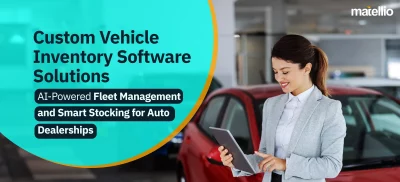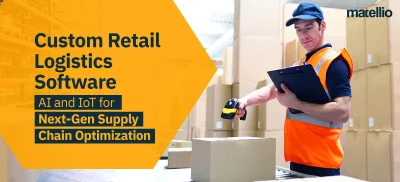
The Internet of Things (IoT) is an integral part of the future of technology in the app development industry. Major industries including healthcare, automotive, logistics, smart homes, and manufacturing are utilizing IoT development services. IoT-based driver management is one of the most exemplary applications in this segment today. From tracking to analytics, an IoT driver management app helps drivers and managers be up-to-date with everything in real time. According to the report by G2, 32% of GPS tracking feature users were reported to welcome a good ROI within 6 months in 2021. The adoption of fleet management technology increased by 8% in 2020.
It is evident from the above numbers that IoT-based driver management applications can help fleet managers optimize their processes. And if you are looking to develop a driver management application for your business, then in this post we talk about everything you need to know to get started.
How Does an IoT-Based Driver Management App Work?
Fleet management, like various other industries, has met a remarkable shift in the way it works using IoT technologies. The vehicles are armed with sensors (in the guise of onboard boxes) that are connected to the Internet. This allows the flow of real-time information between managers and drivers.
This data can be anything related to the driver’s activities on the road such as the geolocation of vehicles, their status (in movement or stopped), their maintenance (breakdowns or issues related to wear), fuel consumption, or even availability of the vehicle.
The data is generated via dashboards which work as a part of the driver management system application. It is analyzed to enable the manager to manage his drivers and resources. An IoT-enabled driver management app gives a hand in measuring as well as monitoring driver safety and it also contributes to efficient vehicle performance. This type of solution can be employed across various industries. IoT apps also help in reducing fleet management costs.
Read More: What is Fleet Management Software and Why opt for it?
These solutions can be configured to discover and trace abrupt braking or acceleration, high-speed or sudden turning, rapid speeding, frequent stops, and not to forget – slow driving. This supervision is performed individually for every driver. The reports can be used to have a graph of a driver’s performance and can also be useful in identifying drivers with issues like fatigue or unsafe driving practices.
Benefits of IoT-Enabled Driver Management Application
Let us look at the benefits of IoT driver management solution:
Driver Behavior Management
Driver management solutions help keep a watch on driving behaviors that include sudden or insufficient braking, high-speed or abrupt turns, fleet-footed acceleration or jerks on the wheel. Monitoring these types of approaches helps measure the alertness and the level of safety precautions a driver is implementing while on the wheels.
Real-Time Monitoring
Monitoring driving behavior from time to time helps alert drivers as well as managers about various possible problems like unsafe conditions or fatigue. This practice also helps create a graph of the improvement a driver is making which helps adjust insurance premiums. Moreover, it exposes fleet managers to a clearer view of the overall performance of their drivers.
Reduced Fuel Cost
Apart from ensuring safety and promoting alertness among drivers, an IoT-based driver behavior app backs automotive fleets in reducing the expense incurred out of fuel and other operational costs. Fuel costs make up about 60% of the budget that is typically set for logistics. Thus, they obviously want to cut the penny on fuel whenever and wherever there is a scope. Driver management proves to have a great deal of impact on fuel efficiency, accounting for up to 30% savings.
Less Risk of Road Accidents
One obvious reason why it is being incorporated for driver behavior management is its contribution to the reduction in the count of accidents. IoT driver management app informs both drivers and managers about the on-road dangers in real-time. It also helps keep track of driver’s behavior which leads to proactive measures to avoid accidents.
Top 10 Features Your IoT Driver Management Software Must Have
Tracking
The driver management app has GPS vehicle tracking feature which allows your delivery staff to check the exact location of a vehicle in real-time and see how far it is from the actual destination of delivery. You can seamlessly trace the movement of your vehicle back to check the time, calculate cost and verify the route.
Driver Profile
IoT-based driver management app brings this feature to keep your driver records organized, updated, and easily accessible from any location. Driver managers can always see if a driver has a valid license and set up reminders for those who need to renew their licenses. It also helps them check the medical condition of their drivers.
Behavior Monitoring
When you have skilled drivers, there is relatively less risk of accidents and you can save up to 12 percent of driving costs. Employing this feature in your IoT-based driver management app development will enable you to take immediate action in case a driver reflects the signs of reckless driving, fatigue, or distraction.
Hours of Service with E-Logs
You can implement the e-logging system with an IoT driver management app by attaching electronic logging devices to a vehicle engine. It will automatically note the total working time of your driver.
Road Hazard Alert
This feature is one of the core functionalities for an IoT-enabled driver management software development. Altering functions help your drivers have knowledge about the state of the road, weather conditions, and any last-minute change of route. This information is processed in real-time which keeps the driver in the loop. This feature notifies drivers when they are moving towards potential roadway weather hazards as well.
Accident Detection and Reporting
If a driver meets with an accident, the driver management software will help you capture relevant data live from the field for
making further support claims, repairs, as well as risk management. With custom fleet management software, fleet managers can easily track the progress of the accident including repair costs. Apart from that, the software will also help analyze the accidents and generate reports for potential risks and requirements related to driver training.
Control
In an IoT-based driver management app development, you must consider implementing vehicular control mechanisms. This function is useful when it comes to enabling the tracking option and reducing the speed of a vehicle. Note that this feature can be a great asset in the case of retrieving stolen vehicles.
Roadside Assistance
If drivers come across any experience surrounding a roadside issue, they can raise a request for help through their telematics device using the integrated roadside assistance service. Roadside assistance solution notifies the closest provider about the driver’s service request, making sure that they get a fast response. Drivers can also track the service vehicle as it drives to their location.
Dash Camera
A dash cam is an excellent feature for your IoT driver management app development. It automatically captures photos, records videos, and also creates panorama thumbnail views. So, a dash cam can present a playback of the entire event to you. Integrated with telematics, it provides access to the incidents and driver behavior.
IoT App Development Process for Driver Management
The process to develop an IoT application is factored and concluded based on a number of parameters. Parameters such as development cost and time can significantly impact the IoT app development process.
Let us take a look at the steps the process typically involves.
Decide
This is your ‘The Plan’ phase in which you bridge the gap between your idea and the identification of all the elements it will require to turn into a reality. This step can take time as it involves getting the fine print of the goals and objectives of your company and then discovering and fulfilling the requirements that follow. At this stage, the achievement is when you know how to hit a balance between the company’s goals, timeline, and budget while keeping the expectations of users in the bloom.
Select the Hardware
Choosing the right hardware for the IoT app development is a crucial step. When the IoT app development companies don’t build hardware internally, you can simply get the most suitable ones from the most reputable and reliable vendors. Don’t take a step of haste in this phase. You need to carefully make a choice as the hardware for your IoT app should check all the must-haves that meet the standards of your project.
Choose the App Development Platform
You will have a variety of IoT app development platforms to choose from. IoT developers go for different platforms in order to make sure their products are connected to a unified system. Some of the major IoT app development platforms are Android Things, Xively, Homekit, Ubidots, and Azure IoT Suite.
Read More: Tips for Successful IoT App Development
The Design Phase
Once you have the hardware and the right IoT development platform, you need to move to the part that encompasses the speed and performance of your app as it has a lot to do with the design process. The app should be ready enough to attend various transitions within this one stage. Since most IoT apps gather data in real-time, even a matter of one second’s delay can act like minutes. Apart from the performance, it is the security of the app that should be taken care of at this stage.
Test and Tweak
Testing the most critical side of the entire IoT app development process. It is because this practice exposes the feasibility and brings in the chance for you to deal with any problems. After all, you don’t want to treat the consumers to an error-studded IoT app. This stage allows you to discover and eliminate any compatibility issues that may be boiling between the software and the hardware.
Surprising discoveries and changes in the UI/UX or other operational facets of your IoT app should not baffle you. The best changes you come across occur only after the testing phase. Once you have checked the list of every aspect of the green, your app will be ready to step out in the market.
Technology Stack for IoT App Development
The technology stack required to create an IoT app includes the framework, hardware and sensors, programming language, cloud IoT platform, and protocol. The most-fitting technologies are chosen based on the niche chosen for the IoT app.
- Programming Languages: C/C++, JavaScript, Python, Ruby
- Frameworks: Node.js, IoT.js, Device.js, AngularJS
- Cloud Platforms: AWS (Amazon Web Services) IoT, Google Cloud IoT, Microsoft Azure IoT, Arduino (open source), IBM Watson, OpenHAB
- Hardware: Arduino, Google TPU, FPGA controllers, Raspberry PI
- Sensors: 1-Wire, Analog, ADC, RF433
- Protocols: AMQP, Wi-Fi, 2G/3G/4G/LTE/5G, MQTT
How Much Does It Cost to Build an IoT App for Driver Management?
You have to consider a slew of factors before you finally realize the IoT app development cost. From planning and setting goals and choosing from the top IoT app development companies to finding the right tools, the right IoT app development services and then marketing, there is a lot that participates in the process.
Here are some of the eminent factors affecting the IoT app development cost:
- The scope of operational aspects
- Tech stack
- Hourly rate of IoT app developers
- Location of developers
- Third-party services
With the help of the right IoT app development company, you can meditate on all the factors that will possibly contribute to the overall cost of the process.
Kick-Start Your IoT App Development Project for Driver Management
The way IoT gathers every nook and corner of the internet in one place, we can easily see more comfort and seamlessness in our lives. With IoT app development for driver management, you will be able to bring more discipline and render safety in the transportation sector.
Building an app with an in-trend technology like IoT requires you to partner with an experienced IoT app development company. If you are in search of highly-skilled and experienced IoT app developers in the field of IoT app development services, then look no further than Matellio. The fact that we have a team of experts with years of experience in IoT technologies, from LoRaWAN to Zigbee, makes us the right partner to work with on such futuristic projects.
Our IoT experts will keep your goals and expectations in check and will develop the best architecture to fulfill them.








